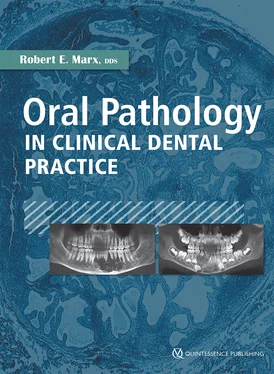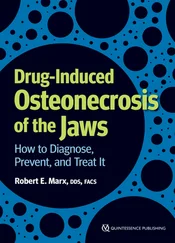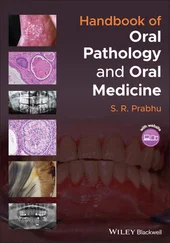Oral Pathology in Clinical Dental Practice

Dedication
This book is dedicated to all those dentists who have picked up on diseases and conditions that have led to an early diagnosis and treatment, thus saving their patients from disease progression, deformity, and at times, even death.
It is also dedicated to those dentists who may have missed the early signs or obvious diseases while focusing exclusively on the dentition. It is hoped that this book will provide examples and guidance as well as the encouragement to be a diagnostician before being a treatment provider.
Library of Congress Cataloging-in-Publication Data
Names: Marx, Robert E., author.
Title: Oral pathology in clinical dental practice / Robert E. Marx.
Description: Hanover Park, IL : Quintessence Publishing Co. Inc., [2017]
|
Includes bibliographical references. | Description based on print version
record and CIP data provided by publisher; resource not viewed.
Identifiers: LCCN 2017028350 (print) | LCCN 2017028970 (ebook) | ISBN
9780867159073 (ebook) | ISBN 9780867157642 (hardcover)
Subjects: | MESH: Mouth--pathology | Jaw--pathology | Face--pathology | Mouth
Mucosa--pathology | Mouth Diseases--pathology | Jaw Diseases--pathology
Classification: LCC RK301 (ebook) | LCC RK301 (print) | NLM WU 140 | DDC
617.5/22--dc23
LC record available at https://lccn.loc.gov/2017028350

© 2017 Quintessence Publishing Co, Inc
Quintessence Publishing Co, Inc
4350 Chandler Drive
Hanover Park, IL 60133
www.quintpub.com
5 4 3 2 1
All rights reserved. This book or any part thereof may not be reproduced, stored in a retrieval system, or transmitted in any form or by any means, electronic, mechanical, photocopying, or otherwise, without prior written permission of the publisher.
Editor: Leah Huffman
Design: Erica Neumann
Production: Sue Robinson
Printed in the USA
Preface Preface Dentists and their dental hygiene team historically have been the great identifiers of oral diseases—not only the common ones of dental caries and periodontal inflammation but also those of oral cancers, serious infections, systemic diseases, and many more. I have personally seen astute “pickups” by referring dentists that have identified serious conditions that actually saved lives. The early recognition of an abnormality, no matter how trivial it may seem at first, can result in a better chance for cure or control and treatments that reduce deformities and disabilities. On the other hand, I have also treated individuals in whom a denture was made incorporating the expansion of a tumor and several times a history consisting of repeated dental restorations around a fungating cancer. Although this other side of the coin is less common, it is a reality. This book was written to encourage the early recognition of oral disease and guide the dentist and dental hygiene team in how to recognize certain conditions and what path to take that will most benefit the patient. It also reviews each condition/disease in a concise manner so as to keep them up to date on how the disease develops, who is most likely to present with it, the clinical and radiographic appearance, a reasonable differential diagnosis, a brief overview of the most common microscopic appearance, and, importantly, a suggested course of action—that is, when to observe and for how long, when to refer and to whom, when to biopsy, and when to order tests and for what, etc. It is hoped that the descriptions and representative photographs as well as the guidance for each disease will help each dentist and dental hygiene team member become a complete oral health care professional and in doing so save a life or two.
1 1 Recognizing Abnormalities and Pathologic Conditions This book is the progeny of a previous two-volume comprehensive oral and maxillofacial pathology text written by this author and pathologist Diane Stern. The original volumes included detailed workups, differential diagnoses, and treatments aimed at treatment providers, predominantly oral and maxillofacial surgeons. However, it is usually the practicing restorative dentist or another specialist that recognizes an abnormality or a pathologic condition during the patient visit. It is for these practitioners that this text is provided. Although it discusses the final treatment of each lesion, it more importantly advances a “suggested course of action” that the recognizing practitioner should consider. The recognition of abnormalities and pathologic conditions requires a three-pronged approach of “listen-look-plan” and is within the training and scope of every dentist. |
Recognizing Abnormalities and Pathologic Conditions 1 Recognizing Abnormalities and Pathologic Conditions This book is the progeny of a previous two-volume comprehensive oral and maxillofacial pathology text written by this author and pathologist Diane Stern. The original volumes included detailed workups, differential diagnoses, and treatments aimed at treatment providers, predominantly oral and maxillofacial surgeons. However, it is usually the practicing restorative dentist or another specialist that recognizes an abnormality or a pathologic condition during the patient visit. It is for these practitioners that this text is provided. Although it discusses the final treatment of each lesion, it more importantly advances a “suggested course of action” that the recognizing practitioner should consider. The recognition of abnormalities and pathologic conditions requires a three-pronged approach of “listen-look-plan” and is within the training and scope of every dentist. |
| 2 |
Red and White Lesions |
| 3 |
Masses Within the Soft Tissues of Oral Mucosa |
| 4 |
Oral Mucosal, Facial, and Neck Masses |
| 5 |
Infectious Diseases of the Jaws and Oral Cavity |
| 6 |
Radiolucent Lesions |
| 7 |
Radiopaque and Mixed Radiolucent-Radiopaque Lesions |
| 8 |
Radiopaque Lesions in Soft Tissue |
| 9 |
Pigmented Lesions of Mucosa and Facial Skin |
| 10 |
Lesions of the Facial Skin and Oral Mucosa |
| 11 |
Exposed Bone Pathologies |
| 12 |
Vascular Lesions of Oral Mucosa and Skin |
Recommended Reading
Dentists and their dental hygiene team historically have been the great identifiers of oral diseases—not only the common ones of dental caries and periodontal inflammation but also those of oral cancers, serious infections, systemic diseases, and many more. I have personally seen astute “pickups” by referring dentists that have identified serious conditions that actually saved lives. The early recognition of an abnormality, no matter how trivial it may seem at first, can result in a better chance for cure or control and treatments that reduce deformities and disabilities.
On the other hand, I have also treated individuals in whom a denture was made incorporating the expansion of a tumor and several times a history consisting of repeated dental restorations around a fungating cancer. Although this other side of the coin is less common, it is a reality.
Читать дальше














